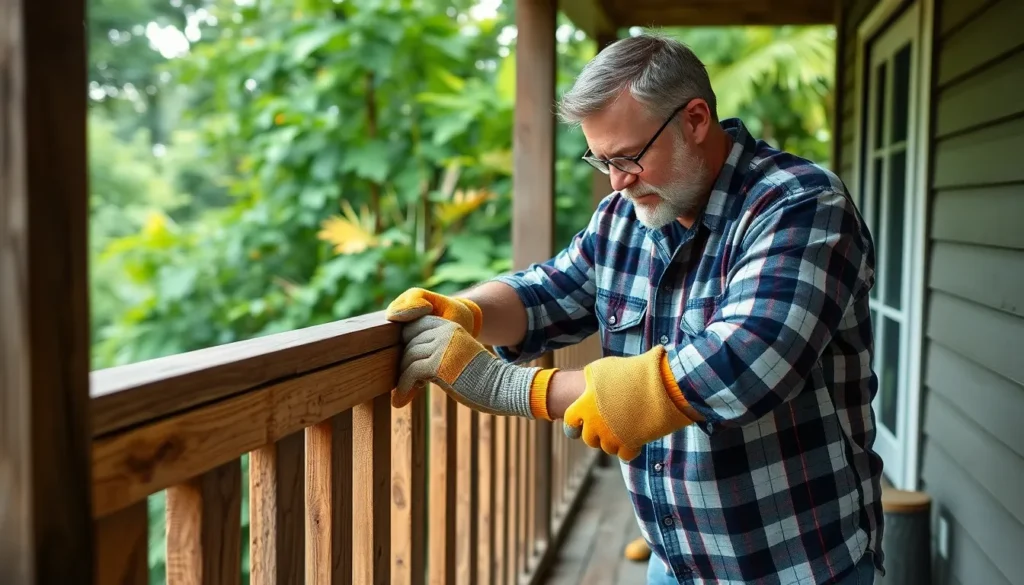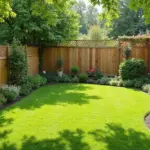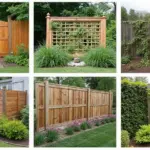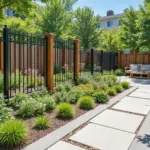We’ve all stood on our porches dreaming of a stunning makeover that won’t drain our bank accounts. The good news? Transforming your porch railings doesn’t require a contractor’s budget or professional skills. With the right DIY approach and creative materials you can create beautiful custom railings that rival expensive installations.
Budget-friendly porch railing projects are easier than you think. From repurposed materials like old fence pickets to simple PVC pipe designs we’ll show you how to achieve that perfect blend of safety style and savings. These DIY answers typically cost 60-80% less than hiring professionals while giving you complete creative control.
Whether you’re working with wood metal or composite materials there’s a cost-effective railing solution that matches your home’s aesthetic. We’ve compiled the most practical and affordable ideas that weekend warriors can tackle with basic tools and a bit of determination.
Repurpose Old Materials for Affordable Porch Railings
Repurposing existing materials can slash your porch railing project costs by up to 70% while creating unique design elements that store-bought options simply can’t match.
Use Reclaimed Wood from Pallets
Wooden shipping pallets offer an abundant source of weathered lumber that’s perfect for rustic porch railings. We’ve found that standard pallets typically provide 8-12 usable boards measuring 1×4 inches or 2×4 inches.
Preparation steps include dismantling pallets carefully with a pry bar and hammer to preserve board integrity. Sand each piece thoroughly with 80-grit sandpaper to remove splinters and rough edges. Apply wood stain or sealant to protect against moisture and extend the railing’s lifespan.
Installation techniques involve cutting boards to your desired baluster length and securing them between top and bottom rails with deck screws. Space each pallet board 4-6 inches apart for proper ventilation and visual appeal. Consider mixing different board widths from various pallets to create visual interest.
Transform Old Fence Pickets into Railing Balusters
Discarded fence pickets can become stylish porch railing components with minimal modification required. Most standard fence pickets measure 1×6 inches or 1×8 inches and already feature pointed tops that work beautifully as balusters.
Cleaning and refurbishing starts with power washing to remove dirt and old paint or stain. Fill any nail holes or minor damage with wood filler and sand smooth once dry. Prime bare wood areas before applying your chosen finish to ensure even coverage.
Creative modifications include cutting pickets to uniform heights or creating stepped patterns for visual variety. We recommend alternating full-height pickets with shorter ones cut to 75% of the original length. Add decorative cuts using a jigsaw to create scalloped edges or geometric patterns that complement your home’s architecture.
Repurpose Metal Bed Frames for Industrial Style Rails
Old metal bed frames provide sturdy vertical and horizontal elements perfect for modern industrial-style porch railings. We’ve successfully used both tubular and flat bar bed frame designs in our DIY projects.
Disassembly and preparation requires removing all hardware and mattress support systems from the frame. Cut sections to appropriate railing lengths using an angle grinder with metal cutting discs. Clean all surfaces with wire brushes to remove rust and old paint before applying metal primer.
Assembly techniques involve welding or bolting frame sections together to create horizontal rails and vertical supports. Space vertical elements 6-8 inches apart to meet most local building codes while maintaining the sleek industrial aesthetic. Paint with rust-resistant metal paint in colors like matte black or charcoal gray to complete the modern look.
Safety considerations include checking metal thickness to ensure structural integrity and consulting local building codes about metal railing requirements. Most bed frames use 16-gauge steel tubing that’s suitable for porch applications but may require additional support posts for spans exceeding 6 feet.
Build Simple Wooden Railings with Basic Lumber
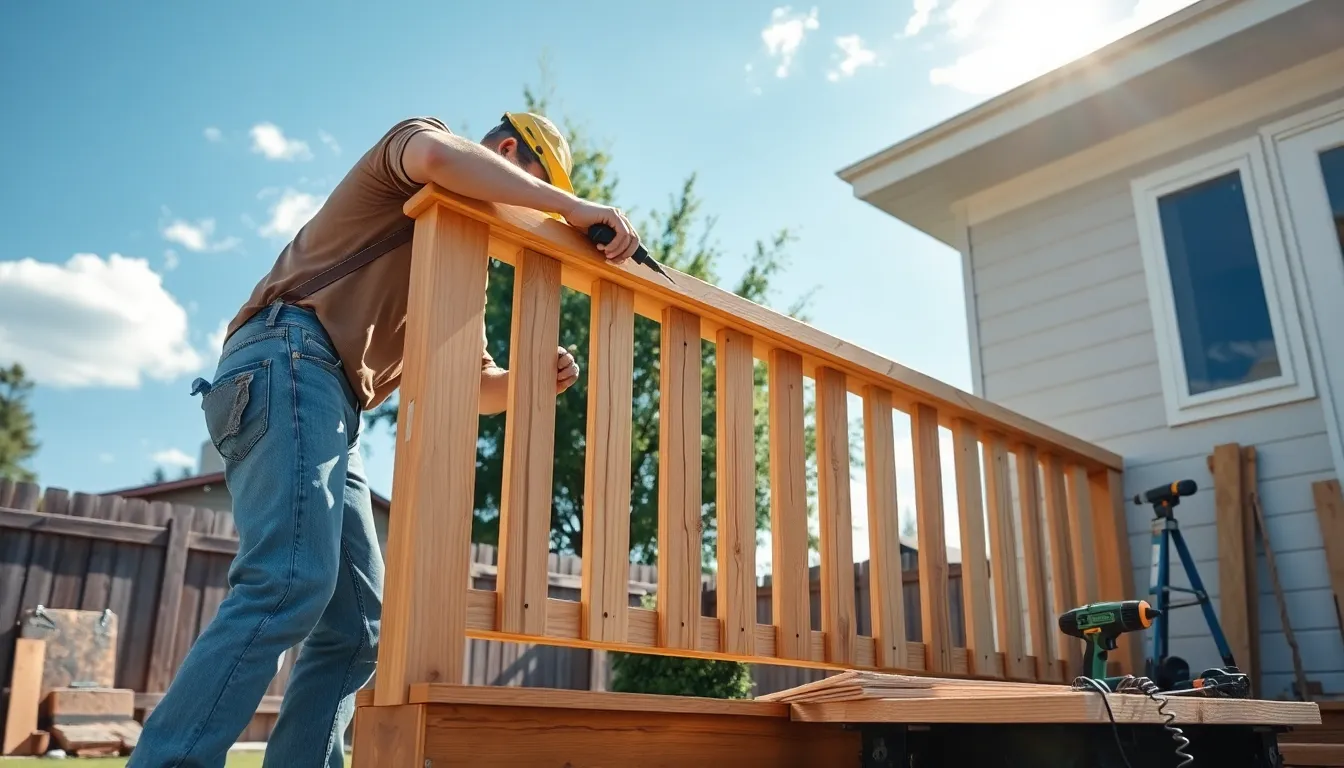
Building with pressure-treated lumber offers the most cost-effective foundation for DIY porch railings. We can construct a sturdy frame using vertical posts and horizontal rails, then customize the infill to match our design preferences.
Create Classic Horizontal Slat Railings
Horizontal slat designs deliver a modern, streamlined appearance that’s perfect for contemporary homes. We start by installing top and bottom rails, then secure wooden slats horizontally between them with even spacing. This layout requires fewer vertical posts than traditional designs, which reduces our material costs significantly.
Pressure-treated lumber works exceptionally well for this style since it withstands weather exposure while keeping expenses low. We can customize the spacing between slats to create different visual effects, from tight, privacy-focused designs to more open, airy arrangements. The straightforward installation process makes this an ideal choice for first-time builders.
Construct Traditional Vertical Spindle Designs
Traditional vertical spindle railings provide classic appeal and excellent safety for families with children. We install evenly spaced vertical balusters between the top rail and either a bottom rail or directly to the deck frame. Simple 2×2 lumber cut to size creates affordable spindles that match any home style.
This design easily meets most building code requirements for railing safety, with spindles typically spaced no more than 4 inches apart. We can achieve professional-looking results by carefully measuring spindle spacing and using a template for consistent installation. The vertical orientation also handles structural loads effectively, making it both beautiful and functional.
Design Crossed Pattern Railings for Visual Interest
Crossed pattern railings add decorative flair while maintaining budget-friendly construction methods. We create X-shaped designs by cutting wood slats and assembling them in intersecting patterns between the top and bottom rails. This approach enhances curb appeal without requiring expensive materials or complex carpentry skills.
Careful measurement becomes crucial for the intersecting pieces to align properly and create clean, symmetrical patterns. We can use basic pressure-treated lumber for durability or untreated wood for immediate cost savings. The crossed design provides structural stability while offering a unique alternative to standard vertical or horizontal arrangements.
Use PVC Pipe for Weather-Resistant Budget Railings
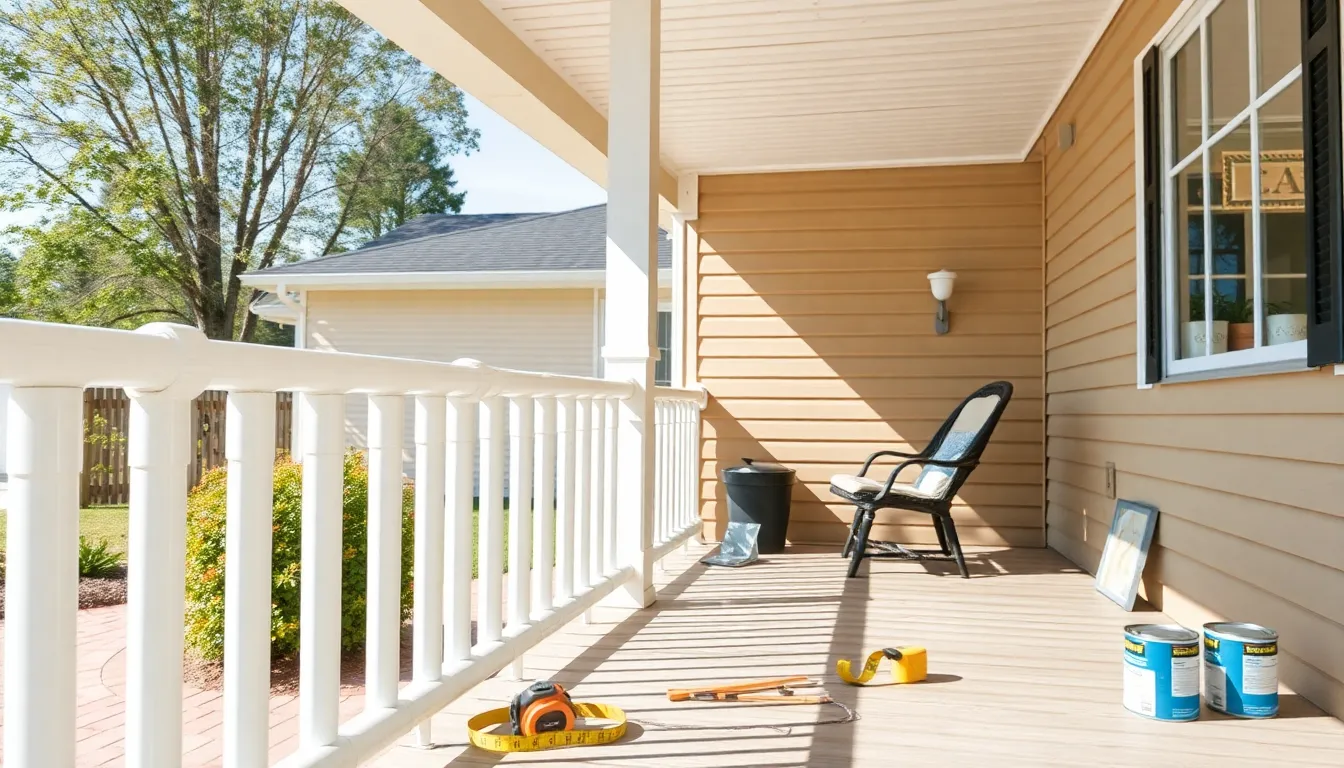
PVC pipe stands out as our top choice for creating durable, affordable porch railings that resist weather damage without the maintenance headaches of traditional materials. This lightweight yet sturdy material won’t rot, rust, or require frequent upkeep, making it perfect for homeowners seeking long-term value.
Install Basic White PVC Pipe Railings
Starting with a simple white PVC design gives us the most straightforward entry point into DIY railing construction. We can create clean, classic railings by installing PVC pipes vertically or horizontally between our existing posts using basic pipe straps and screws.
Measuring our railing sections first ensures we’ll cut the PVC to the proper 42-44 inch standard height required by most building codes. Securing the pipes becomes easier when we initially attach the pipe straps loosely, insert our cut PVC sections, then tighten everything for a perfectly aligned finish.
This basic approach works especially well for first-time DIYers because it requires minimal tools and delivers professional-looking results quickly. The straightforward installation process means we can complete an entire porch railing project in a single weekend.
Paint PVC to Mimic Wood or Metal Finishes
Transforming plain white PVC into sophisticated finishes opens up countless design possibilities without breaking our budget. We can spray paint our PVC railings to resemble expensive materials like copper, bronze, wrought iron, or natural wood using specialty paints designed for plastic surfaces.
Proper surface preparation ensures our paint adheres well and lasts through outdoor conditions. Cleaning the PVC thoroughly and using a plastic-exact primer creates the foundation for a durable, professional-looking finish that rivals much more expensive materials.
Bronze and copper finishes give us an elegant, upscale appearance that complements traditional home styles. Wood-grain spray paints let us achieve the warmth of natural timber without the maintenance requirements or weather vulnerability.
Combine PVC with Wood for Hybrid Designs
Mixing PVC pipe with wood components creates the perfect balance of durability, aesthetics, and cost savings in our railing projects. We can use wood for the posts and top rails to add natural warmth and texture while incorporating PVC for the infill sections that handle the most weather exposure.
This hybrid approach gives us the classic appeal of wood where it matters most visually while keeping maintenance low through strategic PVC placement. The wood elements provide the traditional character many homeowners desire, while the PVC handles the functional aspects without requiring regular staining or sealing.
Installation becomes more flexible when we combine materials because we can customize the proportions based on our exact style preferences and budget constraints. Wood posts anchored securely can support PVC infill panels that we can easily replace or modify as needed over time.
Create Rope and Cable Railings for Modern Appeal
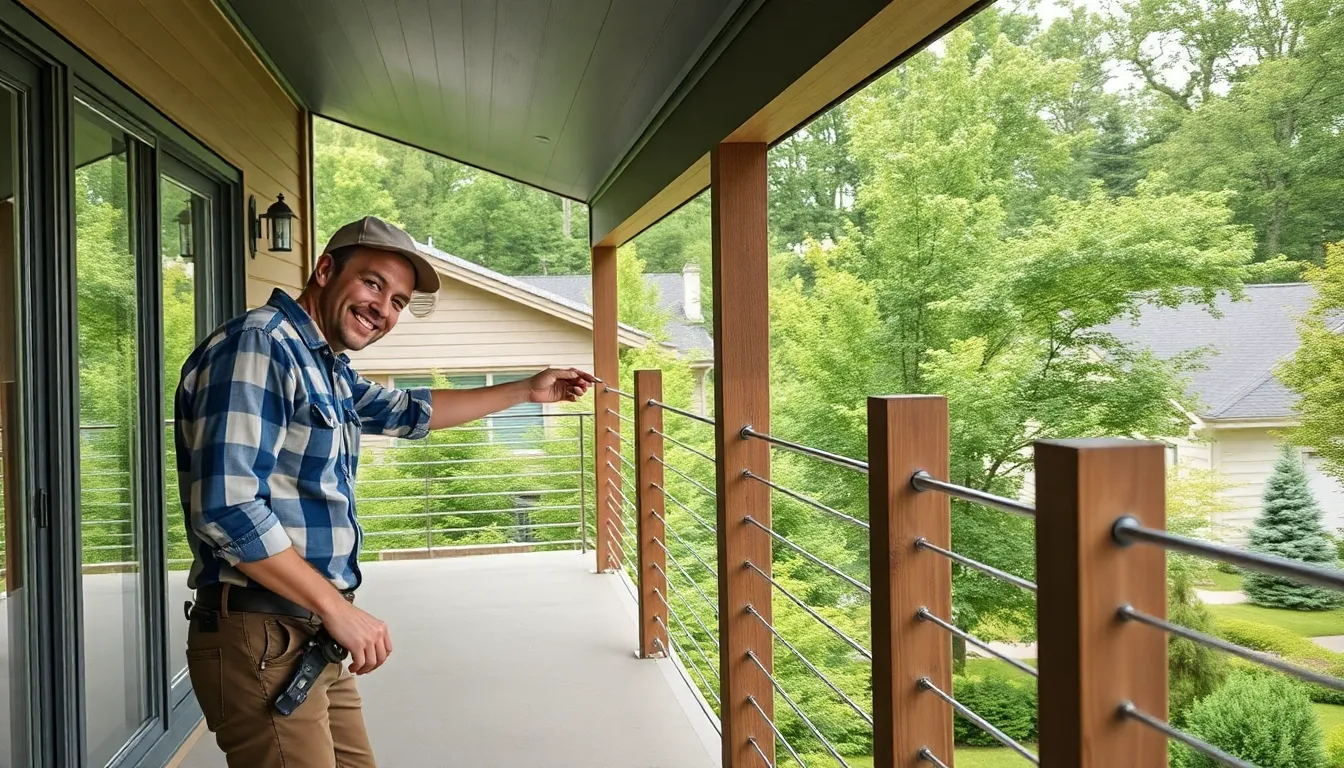
Modern homeowners can achieve sophisticated porch aesthetics without very costly by incorporating rope and cable elements into their railing designs. These materials offer exceptional versatility while maintaining the budget-friendly approach we’ve established.
Install Horizontal Cable Railing Systems
Horizontal cable railings transform ordinary porches into contemporary showcases using pressure-treated wood posts and stainless steel cables. This sleek design creates an open, minimalistic appearance that doesn’t obstruct views while providing essential safety barriers. We can install these systems using basic DIY skills and readily available components, making them perfect for weekend projects.
Steel conduit pipes provide an excellent alternative to expensive cable systems. These pipes can be spray-painted in various metallic finishes to mimic high-end steel cable railings at a fraction of the cost. Installation requires standard drilling tools and basic hardware, allowing us to complete the project without professional assistance.
Kits and pre-made components significantly reduce both material costs and installation time. Many suppliers offer DIY-friendly packages that include all necessary hardware, cables, and detailed instructions. This approach eliminates guesswork while ensuring proper spacing and tension for optimal safety and appearance.
Use Marine Rope for Nautical-Themed Porches
Marine rope railings deliver charming coastal appeal while staying within tight budgets. Thick, durable marine-grade rope strung horizontally or diagonally between wooden posts creates an authentic nautical atmosphere. This style works exceptionally well for lakefront homes, beach houses, or any property seeking a relaxed maritime vibe.
Natural fiber ropes offer eco-friendly alternatives to synthetic materials. These options provide rustic texture and warm tones that complement traditional architectural styles. Installation involves simple threading and securing techniques that most homeowners can master quickly.
Combining rope with metal posts enhances stability and longevity. This hybrid approach allows us to enjoy the aesthetic benefits of rope while ensuring structural integrity meets safety requirements. The contrast between materials also adds visual interest to our porch design.
Combine Rope with Wood Posts for Rustic Charm
Rope and wood combinations create inviting rustic aesthetics using affordable standard lumber and marine rope. Stained or weathered wood posts paired with natural rope deliver authentic farmhouse charm without expensive specialty materials. This approach typically costs 60-80% less than comparable manufactured rustic railings.
Pressure-treated wood posts ensure durability against weather while maintaining budget consciousness. These materials resist rot and insect damage, providing long-term value for our investment. Regular maintenance involves simple rope replacement and occasional wood treatment.
Basic woodworking skills and standard tools make this project accessible to most DIY enthusiasts. Installation requires drilling, measuring, and rope threading – techniques that don’t demand specialized expertise or expensive equipment. We can complete most rope and wood railing projects in a single weekend with proper planning.
Incorporate Natural Materials for Rustic Charm
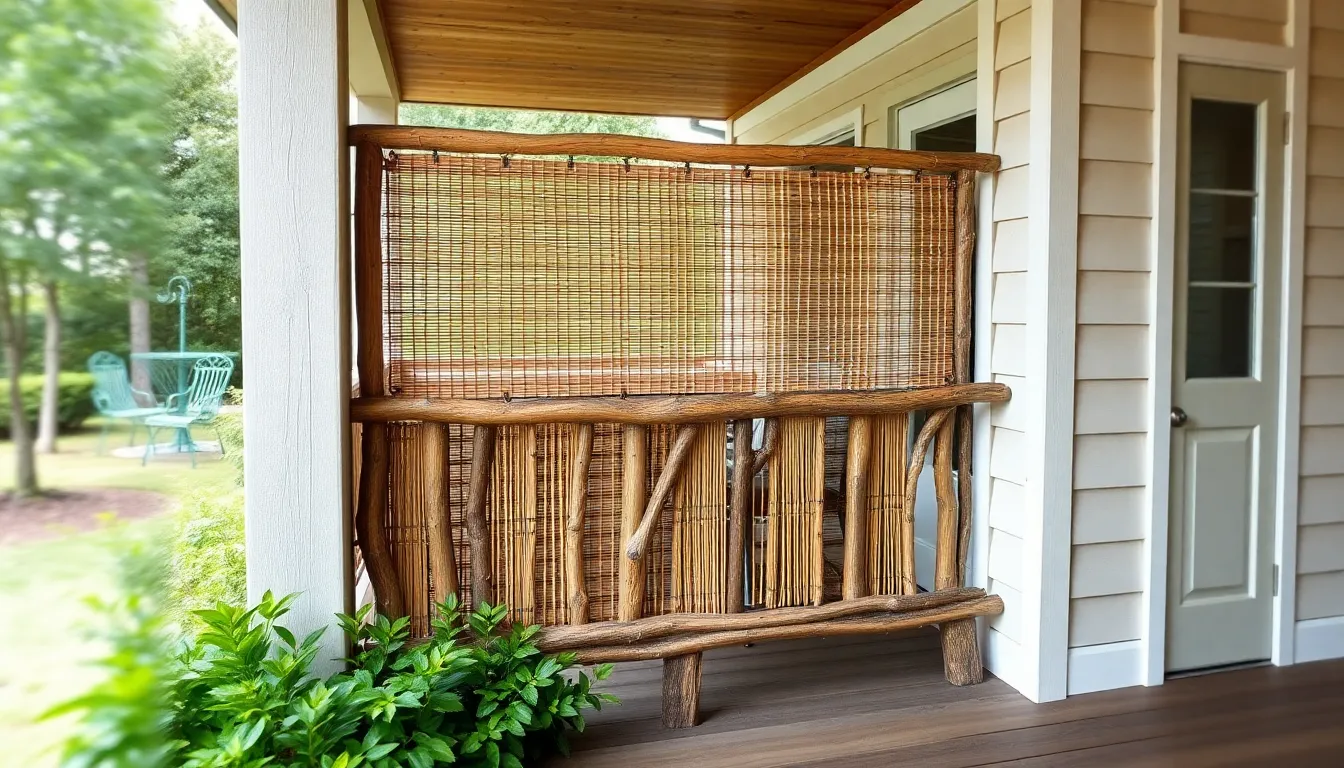
Natural materials transform ordinary porch railings into stunning focal points while keeping costs remarkably low. Pressure-treated wood serves as an affordable foundation that pairs beautifully with organic elements to create that coveted rustic aesthetic.
Use Tree Branches for Unique Organic Railings
Tree branches offer the most distinctive and budget-friendly approach to creating one-of-a-kind porch railings. We can repurpose fallen branches or pruned limbs as vertical spindles or horizontal decorative elements, giving our porches an authentic handcrafted appearance. Their natural curves and varying textures create visual interest that’s impossible to replicate with manufactured materials.
Securing branches between top and bottom rails requires basic carpentry skills and minimal tools. We recommend selecting branches with similar diameters for consistency while embracing their unique shapes for character. Sanding rough edges ensures safety without losing the organic appeal that makes this approach so special.
Install Bamboo Screening for Privacy and Style
Bamboo screening delivers exceptional value by combining privacy, style, and eco-friendly appeal in one affordable package. We can attach bamboo panels to existing frames or use them as infill between posts to create instant visual barriers while maintaining airflow. This material blends seamlessly with wooden structures and adds tropical or Asian-inspired charm to our outdoor spaces.
Installation involves simply securing bamboo screening to our railing framework using galvanized staples or zip ties. We’ll find that bamboo naturally weathers to an attractive silver-gray patina over time, requiring minimal maintenance while providing years of service. Different bamboo thicknesses allow us to customize the level of privacy and visual density.
Create Stone and Wood Combination Railings
Stone and wood combinations create striking contrast while maximizing durability and reducing long-term maintenance costs. We can source stones locally or use reclaimed materials from old foundations or walls to keep expenses minimal. Building stone bases or pillars provides a sturdy foundation that supports wooden rail sections above.
Local quarries often sell irregular stones at fraction of the cost of cut materials, perfect for achieving that rustic, natural appearance we’re after. We’ll position stone elements strategically as corner posts or periodic accents along our railing runs. The weight of stone components actually improves overall stability while the wood sections above maintain the warm, welcoming feel that makes porches so inviting.
Upcycle Household Items into Creative Railing Designs
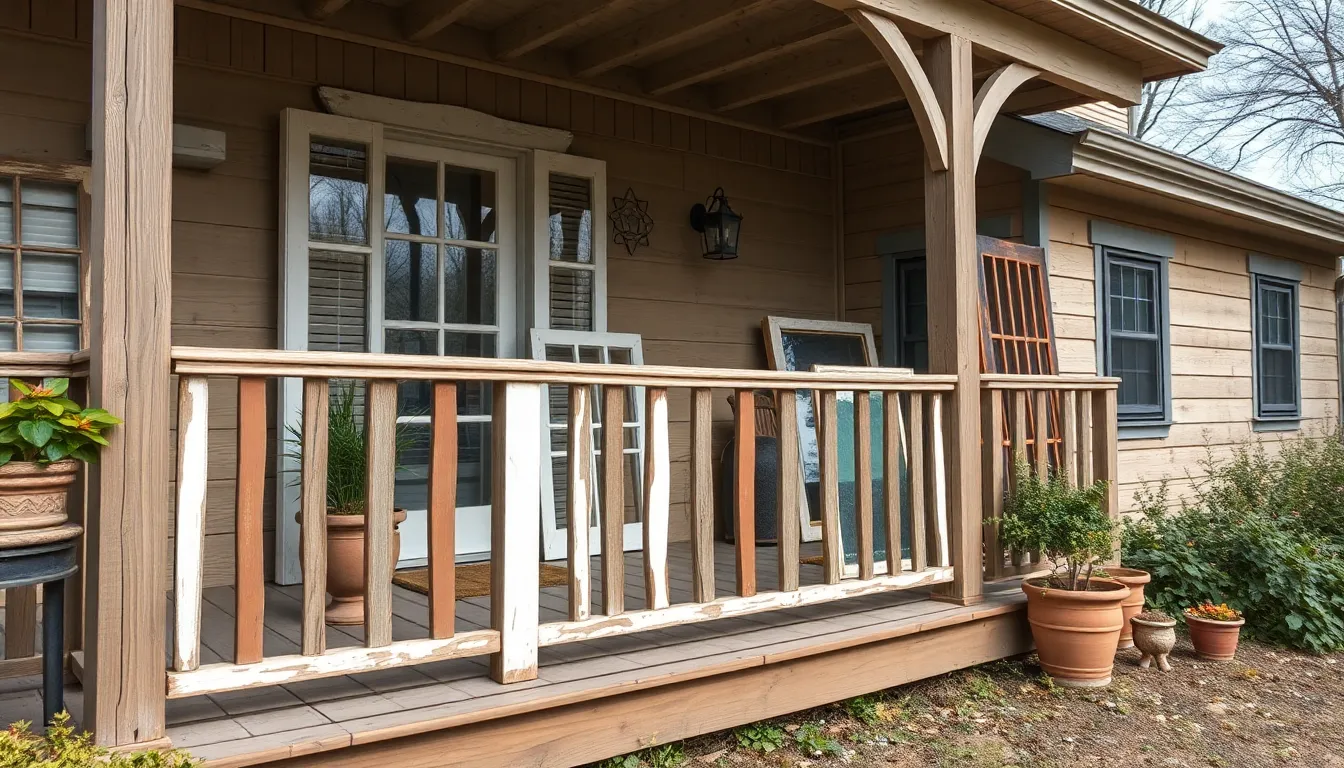
We’ve discovered that some of the most stunning porch railings come from repurposing items we already have around our homes. These creative approaches can reduce our project costs by up to 70% while adding unique character that store-bought railings simply can’t match.
Transform Old Shutters into Decorative Panels
Old shutters make exceptional railing panels when mounted vertically between our porch posts. We can attach these weathered beauties directly to our existing frame using wood screws or brackets, creating instant visual interest with their classic slatted design. Painted shutters work particularly well for cottage or farmhouse style porches, while natural wood shutters complement rustic decor themes.
Preparation involves sanding any rough edges and applying a protective sealant if we plan to leave them outdoors year round. We should measure our railing sections carefully before selecting shutters, ensuring they fit properly between posts. Most standard shutters range from 12 to 20 inches wide, making them perfect for typical porch railing spacing.
Use Vintage Windows as Railing Inserts
Vintage window frames create stunning focal points when incorporated as railing inserts between our posts. We can remove the glass panes for safety or replace them with plexiglass for a cleaner look that still allows light to filter through. These reclaimed windows bring nostalgic charm while serving as functional railing components.
Installing window frames requires basic carpentry skills and proper weatherproofing to prevent moisture damage. We need to secure them firmly using metal brackets or wooden cleats, ensuring they meet local building codes for railing height and spacing. Architectural salvage yards often sell vintage windows for $15 to $50 each, making this an affordable way to add character.
Repurpose Iron Bed Rails for Elegant Details
Iron bed rails transform into sophisticated balusters that rival expensive wrought iron designs when properly repurposed. We can disassemble old bed frames and cut the rails to appropriate lengths using a metal cutting saw, creating custom spindles for our porch railings. These ornate pieces bring Victorian elegance to our outdoor spaces at a fraction of retail costs.
Metal preparation involves removing rust with sandpaper or wire brushes, then applying primer and paint designed for outdoor use. We should space these iron elements according to building codes, typically no more than 4 inches apart for safety. Welding skills help create seamless connections, though we can also use metal brackets and screws for easier installation that most DIYers can handle.
Apply Budget-Friendly Finishing Techniques
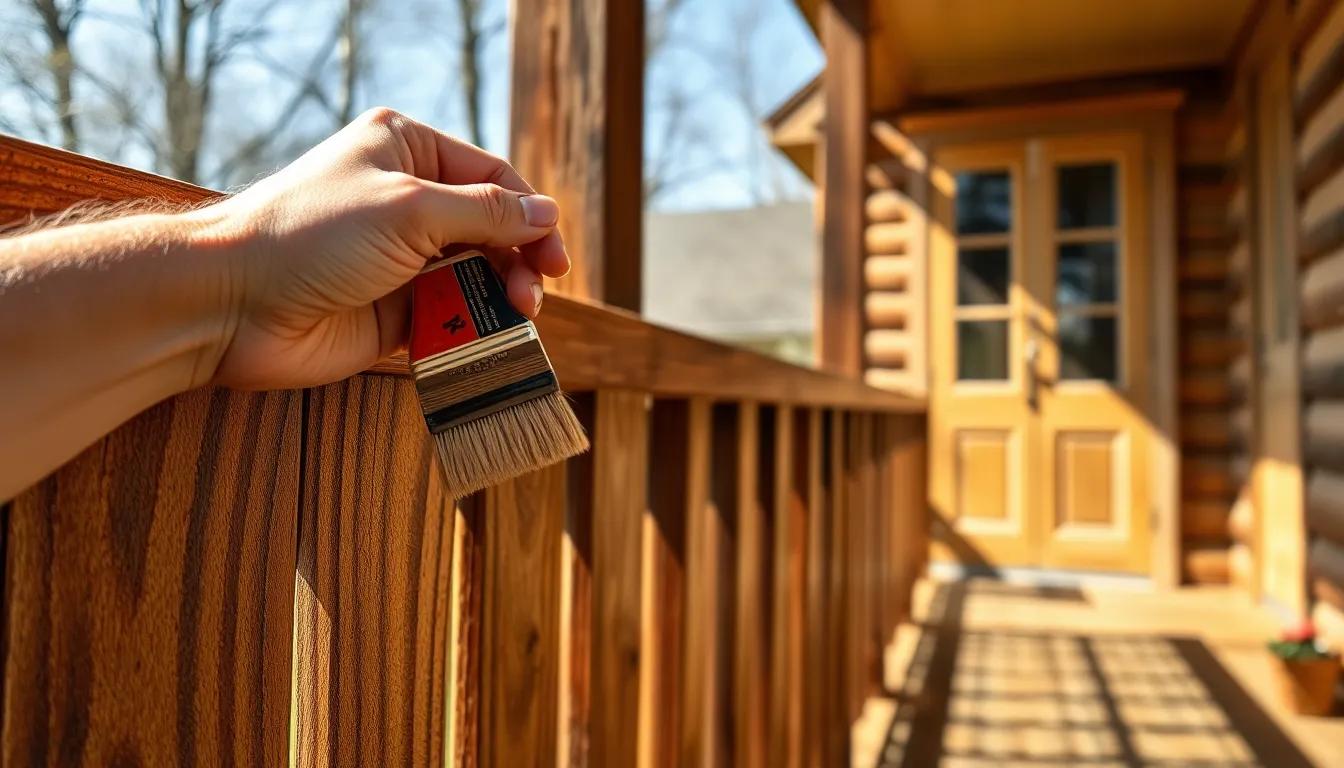
Smart finishing techniques can transform basic materials into stunning porch railings while keeping costs minimal. These methods maximize the potential of inexpensive materials and provide long-lasting protection.
Use Stain Instead of Paint for Cost Savings
Staining wood railings costs significantly less than painting while delivering superior results. Wood stains penetrate deep into pressure-treated lumber, creating a natural appearance that highlights the grain pattern beautifully. We recommend choosing semi-transparent stains that enhance the wood’s character rather than masking it completely.
Preparation requires minimal effort compared to paint, as stains bond directly with the wood fibers. You’ll need basic supplies like brushes, rags, and the stain itself, which typically costs 30-40% less than quality exterior paint. Application takes less time since stains don’t require multiple coats like paint systems do.
Wood stains also last longer on outdoor railings because they move with the wood as it expands and contracts. This flexibility prevents the cracking and peeling common with painted surfaces, reducing maintenance costs over time.
Apply Weather-Resistant Sealers for Longevity
Weather-resistant sealers protect your investment by extending the life of budget materials significantly. These protective coatings shield pressure-treated wood from moisture, UV rays, and temperature fluctuations that cause premature deterioration. Clear sealers maintain the natural wood appearance while providing essential protection.
Application involves cleaning the surface thoroughly, then applying the sealer with a brush or sprayer according to manufacturer instructions. Most quality sealers require reapplication every 2-3 years, but this maintenance schedule prevents costly railing replacement. We’ve found that investing in UV-resistant sealers pays off in climates with intense sun exposure.
Combined with stain, sealers create a two-layer protection system that can double the lifespan of inexpensive wood railings. This approach costs a fraction of premium materials while delivering comparable durability.
Create Faux Finishes with Basic Paint Techniques
Faux finishing techniques transform inexpensive materials to mimic expensive options at a fraction of the cost. Steel conduit pipes can achieve a realistic metal patina look using basic spray paint and simple layering techniques. Start with a base coat of dark brown or black, then dry brush lighter metallics over the surface for authentic weathered appearance.
PVC railings benefit from wood grain techniques using specialty combs and multiple paint colors. Apply a base coat in light wood tone, then drag a wood graining tool through darker glaze for realistic texture. This method creates convincing wood appearance on maintenance-free PVC materials.
Sponge painting creates stone-like textures on smooth surfaces using multiple paint colors and natural sponges. Dab different shades of gray and brown to simulate natural stone patterns on budget materials. These techniques require only basic supplies and can be completed in a weekend, making expensive materials unnecessary for achieving high-end looks.
Conclusion
We’ve shown you that transforming your porch with stunning DIY railings doesn’t require very costly or hiring expensive contractors. From repurposed materials to clever upcycling projects these creative answers can deliver professional-looking results at a fraction of traditional costs.
The key to success lies in choosing the right approach for your skill level and budget. Whether you’re drawn to rustic reclaimed wood designs modern cable systems or innovative PVC answers there’s a perfect DIY railing project waiting for you.
Remember that safety and building code compliance should always guide your decisions alongside creativity. With basic tools determination and the ideas we’ve shared you’re ready to create beautiful custom porch railings that’ll enhance your home’s curb appeal for years to come.
Frequently Asked Questions
How much can I save by doing a DIY porch railing makeover instead of hiring professionals?
You can save 60-80% compared to professional installations by taking a DIY approach. With creative use of materials and repurposing items, homeowners typically spend a fraction of the cost while achieving stunning custom results. The savings are even greater when using reclaimed materials, potentially reducing costs by up to 70%.
What are the best materials for budget-friendly porch railings?
Popular budget-friendly materials include pressure-treated lumber, PVC pipe, reclaimed wood from pallets, and repurposed metal items like old bed frames. These materials offer durability and versatility while keeping costs low. Each material can be customized to match different design preferences and architectural styles.
Can I use PVC pipe for porch railings, and how long does installation take?
Yes, PVC pipe is an excellent choice for durable, weather-resistant railings that require minimal maintenance. A basic white PVC railing system can typically be installed in a weekend, making it perfect for first-time DIYers. PVC can also be painted to mimic more expensive materials like wood or metal.
How do I repurpose old materials for my porch railing project?
You can transform reclaimed wood from pallets into rustic railings, use discarded fence pickets as balusters, or repurpose old metal bed frames for an industrial look. Clean and prepare materials properly, check for structural integrity, and ensure they meet local building codes before installation.
What modern railing designs can I create on a budget?
Modern options include horizontal cable railings using stainless steel cables with wood posts, steel conduit pipe systems as cable alternatives, and marine rope railings for coastal themes. These designs offer contemporary aesthetics while remaining cost-effective and suitable for DIY installation with basic tools.
Are there natural material options for creating rustic porch railings?
Yes, you can use fallen tree branches as vertical spindles or decorative elements, bamboo screening for privacy panels, and combine local stones with wooden sections. These natural materials create unique, handcrafted appearances while being environmentally friendly and often available at little to no cost.
How can I upcycle household items into porch railing elements?
Transform old shutters into decorative panels, vintage windows into charming railing inserts, and iron bed rails into elegant balusters. These upcycling projects can reduce costs by up to 70% while creating one-of-a-kind designs that add character and personal style to your porch.
What finishing techniques can enhance my DIY railing without breaking the budget?
Use wood stains instead of paint for a natural look that highlights grain patterns and requires less maintenance. Apply weather-resistant sealers to protect against elements and extend lifespan. Try faux finishing techniques with simple paint methods to create high-end appearances on budget materials.
Do I need special tools for DIY porch railing projects?
Most DIY railing projects require only basic tools like a drill, saw, measuring tape, level, and screwdriver. Specific projects may need additional tools, but generally, standard household tools are sufficient. Always prioritize safety equipment like safety glasses and gloves during construction.
How do I ensure my DIY porch railings meet safety and building codes?
Check local building codes for height requirements, spacing between balusters, and structural specifications before starting. Ensure proper installation techniques, use appropriate hardware for your material choice, and consider consulting local authorities if unsure about regulations. Safety should always be the top priority in any DIY project.

